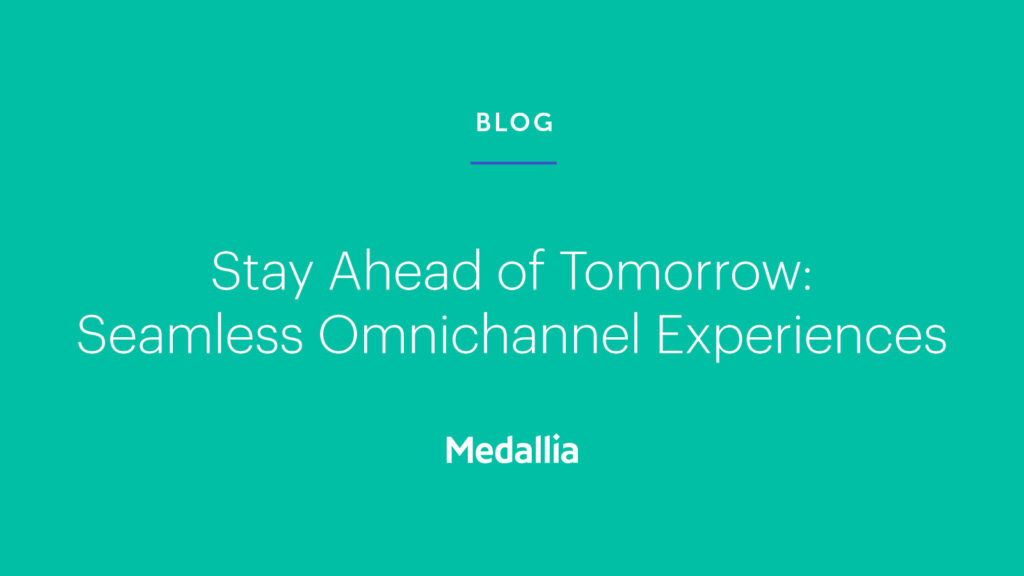How to Deliver a Seamless Omnichannel Experience in a Digital-First World
April 12, 2021
Customer Experience
A seamless omnichannel experience can deliver fast, frictionless and human experiences across all channels.
(EDITOR’S NOTE: This is the final part of our three-part series examining how organizations can stay ahead of tomorrow in these uncertain times, based on interviews with Medallia’s leading experts.)
Consumers today are in the driver’s seat, and their behavior is changing faster than ever. During the pandemic, 76% of consumers changed stores, brands or the way they shop. And, as a result of these changing consumer behaviors, companies across categories have seen digital channel adoption grow between 15% and 40%. What’s more, 75% of customers who report using digital channels for the first time say they plan to keep doing so even after things return to “normal.”
Simply put, customers expect fast, frictionless and personalized digital experiences — but also in those key moments of truth that may involve human interaction. Companies that deliver a seamless omnichannel experience put themselves way ahead of their competitors who do not — and they open up an opportunity to retain customer loyalty. Research shows that 75% of consumers want consistent experiences across multiple channels (web, mobile, in-person, social) and 73% are likely to switch brands if they don’t get it.
Creating a seamless omnichannel experience
Omnichannel customers spend 4% more in a store and 10% more online than single-channel customers. And for every additional channel they use, customers spend more money. That means the customer experience across all channels needs to be seamless.
However, opportunities to engage with your customers in key moments have changed. In the past, you may have found that email or the point of sale in store were the best ways to engage with customers and gather feedback. Now, your biggest opportunity may have shifted to when customers are engaging with your website or app, or reaching out directly to your contact center or via text messaging.
“It’s about meeting your customers where they are,” said Geoffry Ryskamp, Global Head of Medallia’s Hospitality Practice, who has 20 years of experience in the hospitality industry, most recently a founding member of the asset management team at Pebblebrook Hotel Trust. “Call centers will always be important for the customer experience, but not everyone wants to pick up the phone. You need to be available for your customers across multiple channels, including web, mobile and in-app. Most importantly, the experience across these channels has to be seamless.”

If a customer has a 5-star experience on your mobile app, but then the experience doesn’t meet those same expectations when they visit your physical location or website, what’s the likely outcome? When you hone in on your customer experience, making it consistent across all channels, the opportunity to grow customer loyalty increases.
“For example, let’s say a customer is trying to find information on your website about updated cleanliness standards. It’s important that the potential hotel guest knows the procedures before booking, so they may call to find out. How that call is handled can either lead to a booking or the loss of a customer,” Ryskamp added.
Adapting to meet customer needs
With digital now the heart of your brand, you need to learn from the online experiences you offer. Not only will the insights you gather allow you to improve and optimize digital, but you can apply what you learn across all your channels.
“A lot of business has shifted to starting in the digital marketplace but then needs to be fulfilled in the brick-and-mortar locations,” said Mike Debnar, a Solution Principal for Medallia focused on retail and digital innovation, who helped create a digital guest experience while at 7-Eleven that has since led to increased engagement and improved case efficiency. “There’s an execution gap that needs to be understood. Digital synchronization with physical locations is crucial to delivering a seamless omnichannel experience.”
Your customers are telling you what they want from their experiences. You need to listen, and then act on what you learn.
For example, it’s no secret that foot traffic to store locations decreased during the pandemic as many consumers stayed home. But, retailers that managed to adapt and innovate to cater to these new consumer behaviors quickly offered buy online pickup curbside services. As a result, they were able to gather real-time feedback across multiple channels — from websites, email surveys, apps, and those in-person interactions. Those insights allowed them to learn about and resolve any issues that affected this new customer experience across channels.
“By seeing where customers are interacting with you and the types of transactions they are trying to complete, businesses can identify and resolve multiple issues impacting customers,” said Jason Pontelin, a director of professional services for Medallia, who works with customers across healthcare, life sciences, telecommunications and utilities. “This has helped them increase customer satisfaction and ensure transactions can be completed seamlessly across multiple channels, allowing customers to choose their preferred path.”
Connecting the dots, and the tech stack
Digital first doesn’t mean you can take the human aspect out of your customer experience strategy. Consumers expect businesses to know their history and preferences across every touchpoint. Organizations that can’t consolidate the data or those operating in silos can be left blind to what the customer has said, done and experienced.
“A disparate technology stack can cause increased friction for customers and limit organizations from creating personalized experiences, optimizing marketing spend and effective cross-selling,” said Zack Hamilton, Medallia’s Solution Principal for Retail, who previously spent over 10 years leading customer experience strategy, customer service operations and sales strategy for a North American retailer. “Integrating digital technology systems puts organizations in control of their customers’ data, enabling them to deliver better experiences.”
By uncovering precise areas of interest or where customers experience friction, you can deliver a seamless omnichannel experience that drives more positive outcomes for your customers — and your business.








